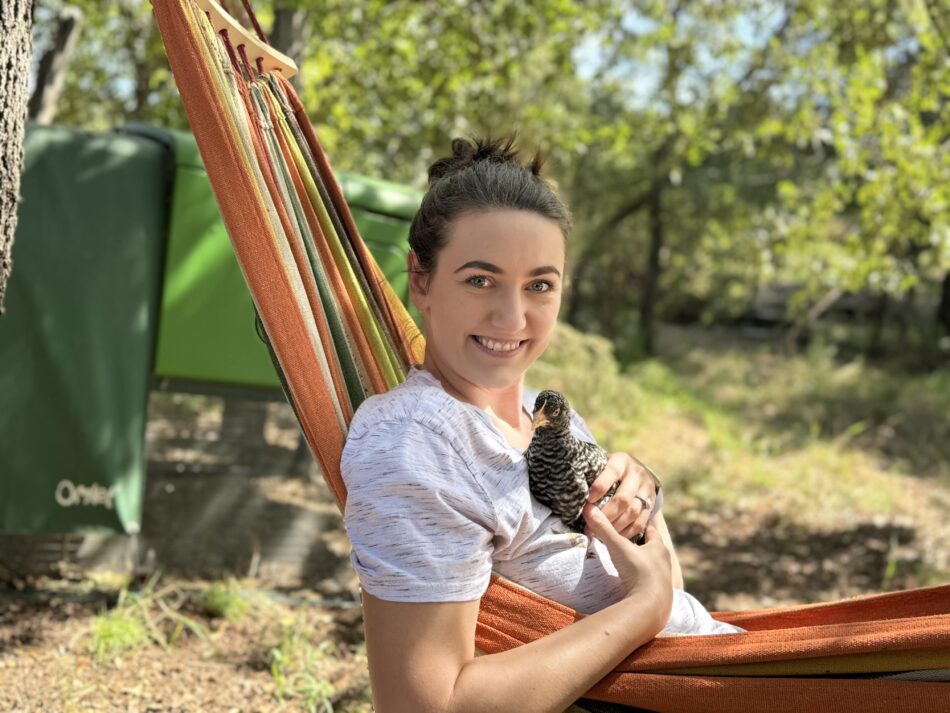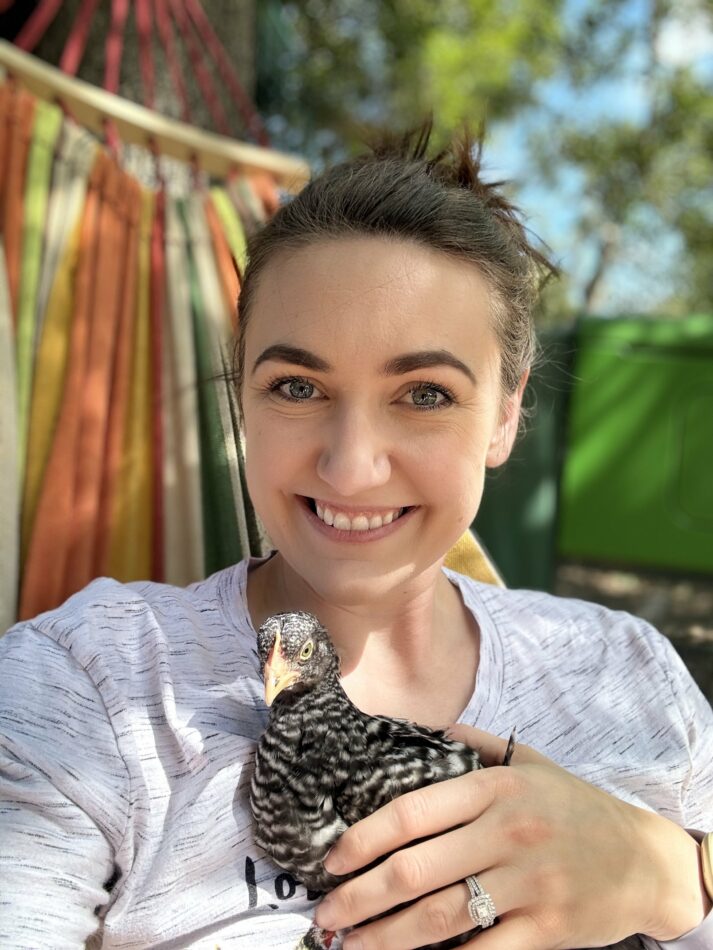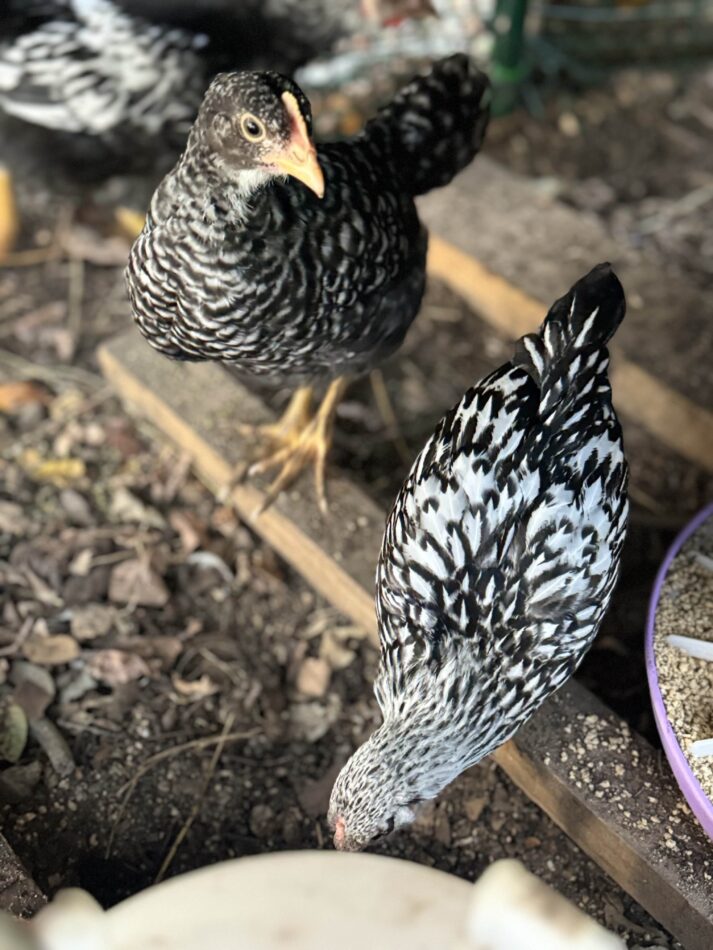A first-hand look at raising chicks in the fall – part 2
Hey y’all! My name is Alyssa Holland, and I live on a small hobby farm in north-central Texas. We have all kinds of animals on our farm: horses, goats, a miniature pig, rabbits, guinea pigs, dogs, cats, fish, and of course — chickens! We have around 25 chickens currently, and tend a mixed flock of many different breeds. Most recently, we’ve added a rescue pigeon to our flock that thinks she’s a chicken!

Welcome back to my fall flock-raising adventure! My group of six chicks are thriving in the cool(ish) temperatures, and they’re growing like weeds. Their personalities are starting to shine, and preparations for their future accommodations are being made. See what we’ve been up to, and what I’m expecting throughout the rest of the fall season.
How they’re growing
Y’all, chicks grow fast! And, since I started with older chicks, time has flown. Both breeds were fully feathered around 6 weeks old and are growing at the same rate — which has made brooding them together a breeze!
The chicks are around 7-8 weeks old now. The Silver Laced Wyandottes are beginning to show their gorgeous coloring, and the barred pattern of the Plymouth Rocks are on full display. I removed their brooder plate last week once they were fully feathered. I usually keep a heat source in with my chicks until they are closer to 8 weeks old, but since the weather is still very warm during the day (high 80s to mid 90s) and has not been dipping below 75 degrees at night, I went ahead and removed their heat.
We hopefully have all pullets from this batch! I rolled the dice a bit by getting the Silver Laced Wyandottes — they were straight runs that had outgrown their pen. Our Tractor Supply store was kind enough to let me hand pick my own chicks, so I compared feathers and combs and selected what I hoped were 3 females, but only time will tell. The Plymouth Rocks were pullets, but earlier this year I purchased two Plymouth Rock pullets, and we now have a beautiful Plymouth Rock rooster! It was a good reminder that unless a breed is a sex link (can be sexed at the time of hatching by feather patterns or color), mistakes can happen. Thankfully, our property isn’t subject to animal restrictions, so we are able to keep roosters, so long as they live peaceably with the rest of the flock (and don’t chase my children!).
Future flockmates
Normally I don’t count my chickens — before or after they hatch! Chicken math gets me every time. So instead of counting my birds and measuring the square footage of our coops and runs, I measure our “chicken saturation” by their health and happiness. If everyone is thriving, it’s a stable and sustainable flock!
We have two setups: one is a very large chicken coop and run that my husband built shortly after we moved in over 5 years ago, and the other is an Omlet Eglu Cube with an attached 6×9 ft Omlet walk in chicken run. Our homemade setup houses around 18 hens and 2 roosters, with another 4 hens and 1 rooster calling the Eglu Cube home. The chicks I’m currently raising will be placed in the flock that best matches their personalities, with some consideration given to space requirements. I try to keep my smaller or more docile hens in the Eglu Cube setup partly because of the size, but also because it’s easier for my kids to access both the eggs and the run to play with their favorite hens! We try not to play favorites, but every flock inevitably has favorites that steal the hearts of their keepers.
It’s hard to determine where chicks will fall in the pecking order, but usually, newly introduced chicks will be toward the bottom of the hierarchy. Since my chickens are kept in runs, I have fellow flock-raising friends that free-range on standby to accept any birds that don’t fit in with my flocks. It’s a rare occurrence, but occasionally a dominant hen or a very low-ranking hen has to be rehomed to a friend to maintain the peace. So, there’s a possibility that one or more of my older hens (or these new chicks), will find their homes on another farm. It’s a win for my friends and a win for the hens — we’re always looking out for the best interest of our flocks!
Establishing a schedule
Chickens thrive on schedules – starting at a young age. Because my chicks are in an outdoor pen, they’re able to follow the natural schedule set by the sun. And, with our other setups within their line of sight, they can take their cue to head to bed from their future flockmates.
Schedules and routines are also helpful when it comes time to handle your chickens. From performing health checks, to just wanting to spend some quality time together – you’ll need to be able to catch your chicks at some point. Schedules are also important to your growing flock’s safety. For example, our miniature pig let herself into our chicks’ pen and they went on a happy excursion through our wisteria vine-covered terrain. But, because they knew their schedule, they headed in to roost when it was time, effectively saving me the trouble of having to chase them down. We decided to let them have their (supervised) free-ranging experience, but even at their young age they were able to put themselves to bed when it was time.
If possible, I highly recommend brooding your chicks in an area that receives natural light. This is another reason why I love using a brooder plate over a heat lamp. Not only do brooder plates carry a lower risk of causing a fire, they don’t emit any light. If your chicks are able to sleep and rise along with natural patterns from early on, it makes the transition to their forever home much easier for everyone!
Activities at this age
Chicks around 8 weeks old are beginning to resemble miniature versions of their full-grown selves, rather than fluffy hatchlings or patchy youngsters. Their colors and patterns are more vibrant, and you can sometimes start to see characteristics of roosters versus hens at this age. And, because they’re bigger and more coordinated, you’ll start to see them display their personalities and desire to play and explore.
I’ve adjusted the angle of their tree limbs and makeshift perch to accommodate their growth and skill level. My son also helped me hang a “chick swing” from the front of their run. And, while it should be noted that it’s not recommended to offer anything other than their chick feed at this age, I’ve started giving small tastes of dried mealworms and dried herbs as treats by hand to my chicks. This gets them used to me being the “treat lady”, and now I can easily get their attention when I shake the treat bag!
Another favorite activity at this age is scratching and dust bathing. They’ve made their own dust bath at the end of their enclosure, but I added some dried oregano to the area for extra incentive. I also give them coastal hay to scratch around in, which is a favorite afternoon activity! Hiding some of their herbs and mealworms in the hay keeps their minds and bodies occupied while I clean their brooder.
I also added a favorite activity of my own to their area: a spot to read! By hanging a hammock across from their enclosure, I can enjoy watching my chicks play and forage and take advantage of the cooler weather. Plus, the central location lets me see my other flocks, so everyone is used to seeing their caretaker curled up with a good book!
What’s next
In the weeks ahead, my chicks will be moved to their permanent homes. As they continue to mature, their genders will be apparent, which will play a large role in how they are placed. Their growing appetites will call for laying feed soon, and we will start introducing them to scratch grains and other protein-packed treats to help them gain weight and maintain healthy plumage throughout the cooler months.


By: Alyssa Holland
This entry was posted in Chickens
